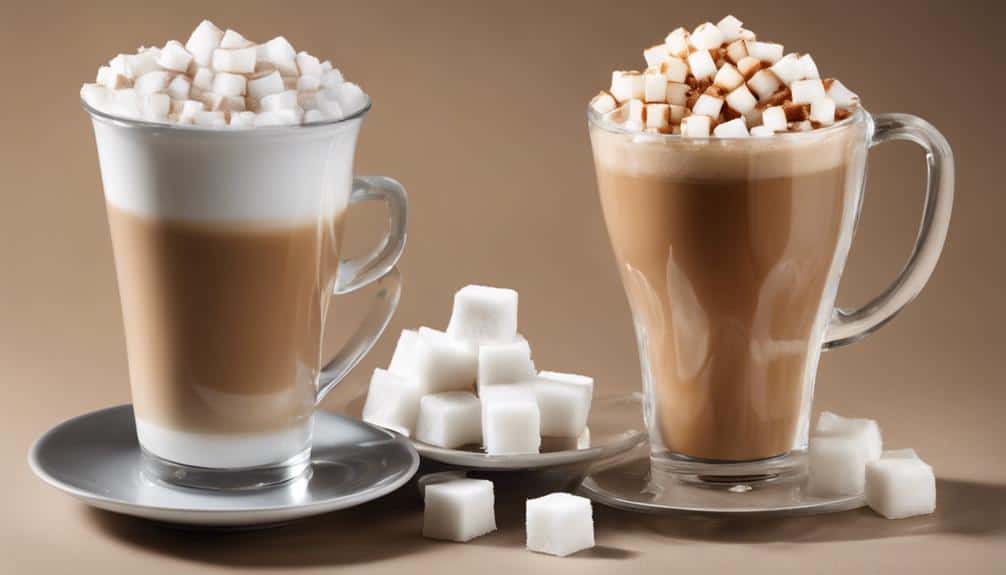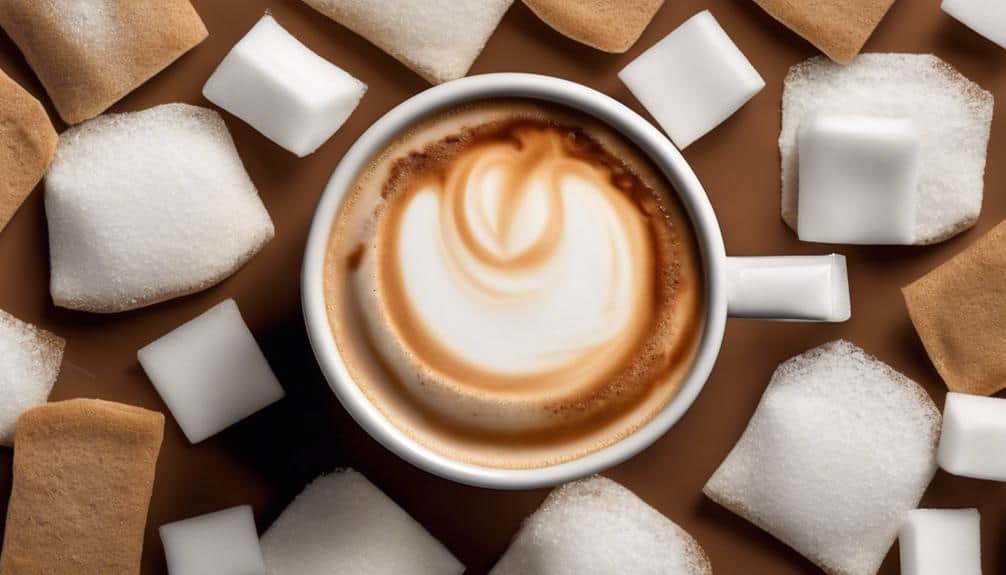What Does a Cappuccino Contain in Terms of Sugar?

Coincidentally, have you ever wondered what exactly goes into a cappuccino in terms of sugar?
The answer might surprise you. Understanding the sugar content in this beloved coffee beverage can shed light on its overall impact on your diet and health.
Let's uncover the truth behind the sugar content in cappuccinos and explore some important considerations when it comes to enjoying this classic drink.
Sugar Content in a Traditional Cappuccino
When examining the sugar content in a traditional cappuccino, it's essential to consider that it typically ranges between 6-9 grams per small cup. This amount of sugar primarily comes from the naturally existing sugar in the milk used to create the creamy texture of the cappuccino. The balance of coffee, milk, and foam in a cappuccino contributes to its overall taste, with the sugar content playing a crucial role in enhancing the flavor profile of the beverage.
Moderation is key when it comes to consuming cappuccinos, especially for individuals mindful of their sugar intake. While the sugar content in a plain cappuccino is relatively moderate, it's worth noting that customization options such as flavored syrups or sweet toppings can significantly increase the sugar levels. Being aware of the sugar content in a traditional cappuccino allows individuals to make informed choices about their coffee consumption, ensuring they enjoy this popular beverage in a way that aligns with their dietary preferences and health goals.
Impact of Flavored Syrups on Sugar Levels
The incorporation of flavored syrups in cappuccinos can substantially elevate the sugar levels present in the beverage. These syrups, such as vanilla, caramel, or hazelnut, often contain high amounts of sugar. In fact, some flavored syrups can add anywhere from 5 to 10 grams of sugar per pump to a cappuccino.
To lower sugar intake, opting for sugar-free flavored syrups is a wise choice. By choosing sugar-free alternatives, one can reduce the overall sugar content in their cappuccino while still enjoying a flavorful experience. It's essential to be informed about the sugar content in flavored syrups to make conscious decisions about sugar levels in beverages.
Making informed choices about the type and amount of flavored syrups added to a cappuccino can significantly impact the overall sugar intake. Therefore, when aiming to reduce sugar levels in a cappuccino, opting for sugar-free flavored syrups is a practical and effective solution.
Comparing Sugar in Regular Vs. Low-Fat Cappuccinos

In comparing sugar content between regular and low-fat cappuccinos, it's evident that regular cappuccinos typically contain around 12 grams of sugar per cup. The sugar content in cappuccinos primarily comes from the natural lactose in the milk used during preparation.
Opting for low-fat or non-fat milk can help reduce the overall sugar content in your cappuccino since these milk types have lower sugar levels compared to whole milk. However, it's important to be cautious with additional syrups or sweeteners as they can significantly increase the sugar content of your drink.
While low-fat cappuccinos may offer a slightly lower sugar content than regular ones due to the reduced fat content in the milk, the difference may not be substantial. Being mindful of the type of milk and any added sugar in your cappuccino can help you make informed choices to manage your sugar intake while still enjoying your favorite coffee beverage.
Exploring Sugar-Free Alternatives for Cappuccinos
To reduce sugar intake in cappuccinos, exploring sugar-free alternatives such as artificial sweeteners like stevia or monk fruit is a beneficial option. These alternatives can help in managing sugar intake and making healthier choices when customizing your cappuccino. Sugar-free syrups and sweeteners are readily available at many coffee shops, providing a customizable option for those looking to reduce their sugar consumption.
Consuming excess sugar in cappuccinos can contribute to health issues like weight gain and diabetes, underscoring the importance of moderation in sugar consumption. By opting for sugar alternatives, individuals can still enjoy their favorite caffeinated beverages without the negative effects of high sugar content. It's essential to be mindful of sugar content in beverages, as even small changes in daily intake can make a significant impact on overall health.
Embracing sugar-free alternatives in cappuccinos can be a simple yet effective step towards managing sugar intake and promoting a balanced lifestyle.
Hidden Sources of Sugar in Cappuccino Ingredients

Examining the various ingredients in cappuccinos reveals unexpected sources of hidden sugars that can significantly impact overall sugar intake. When it comes to cappuccinos, hidden sugars can lurk in various components, altering the perceived sweetness of your favorite coffee beverage. Here are some key sources to be mindful of:
- Flavored syrups and powders: These additives are commonly used to enhance the taste of cappuccinos but often contain high levels of added sugars, increasing the overall sugar content of the drink.
- Toppings: Whipped cream, chocolate drizzles, or sprinkles may seem innocuous but can add a considerable amount of hidden sugars to your cappuccino, elevating its sweetness.
- Non-dairy milk alternatives: While chosen for various reasons, non-dairy milk options can contain added sugars to improve taste or texture. These sugars contribute to the total sugar content of your cappuccino, so it's essential to be aware of their presence.
Conclusion
In conclusion, cappuccinos typically contain about 6 grams of sugar per cup, primarily from the lactose in milk. Flavored syrups can significantly increase sugar levels, while low-fat options may offer a slightly lower sugar content.
Opting for sugar-free alternatives or being mindful of portion sizes can help manage sugar intake effectively. It's important to be aware of hidden sources of sugar in cappuccino ingredients to make informed choices about sugar consumption.





